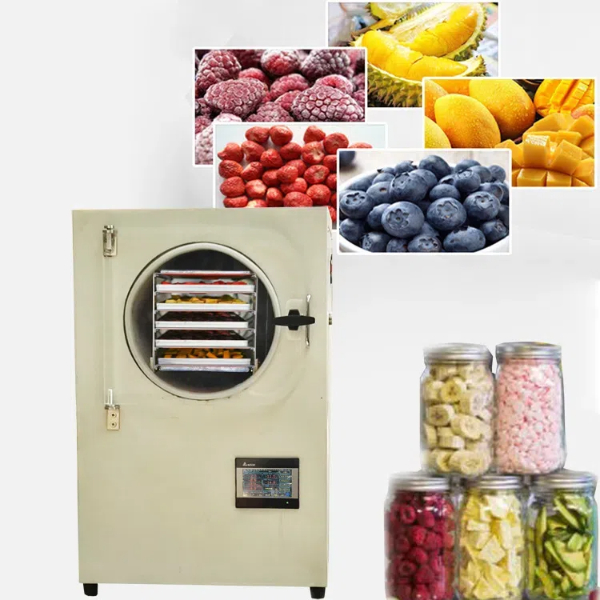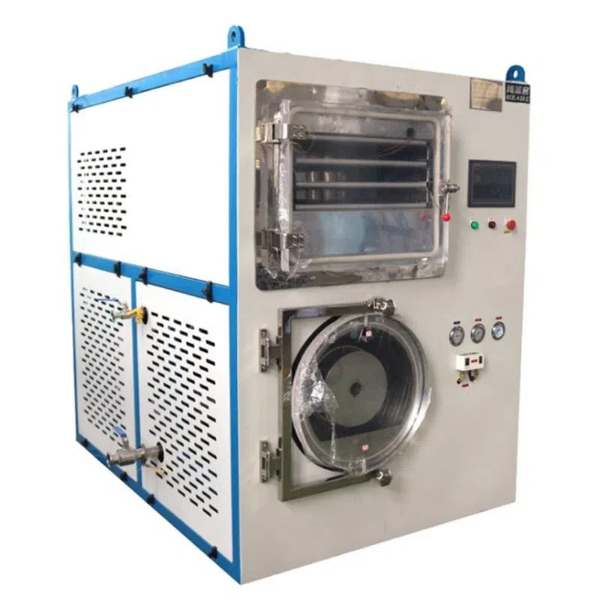
Content Menu
● Introduction
● Understanding Freeze-Drying Technology
● Benefits of Owning a Home Freeze Dryer
● Choosing the Best Freeze Dryer for Home Use
>> Size and Capacity
>> Brand Reputation
>> Features to Consider
● The Freeze-Drying Process: A Step-by-Step Guide
● Freeze-Dried Foods: A World of Possibilities
>> Fruits and Vegetables
>> Meats and Dairy
>> Complete Meals
>> Pet Food
● Maximizing Your Freeze Dryer's Potential
● Maintenance and Care
● The Future of Food Preservation
● Conclusion
● Frequently Asked Questions
>> Q1: How long does freeze-dried food last?
>> Q2: Is freeze-dried food healthy?
>> Q3: Can you freeze-dry liquids?
>> Q4: How much electricity does a home freeze dryer use?
>> Q5: Can freeze-dried food be rehydrated?
Introduction
In recent years, the world of food preservation has been revolutionized by an innovative technology that allows individuals to extend the shelf life of their favorite foods while maintaining nutritional value and taste. This game-changing appliance is none other than the home freeze dryer. As more people become interested in long-term food storage, emergency preparedness, and reducing food waste, the popularity of freeze dryers has skyrocketed. In this comprehensive guide, we'll explore everything you need to know about freeze dryers, from how they work to the best models on the market, and why they're becoming an essential tool in modern kitchens.
Understanding Freeze-Drying Technology
Freeze-drying, also known as lyophilization, is a sophisticated process that removes moisture from food while preserving its structure and nutritional content. Unlike traditional dehydration methods, freeze-drying involves freezing the food and then removing the ice through sublimation, where ice transitions directly from a solid to a gas without passing through the liquid phase.
This process occurs in several stages:
1. Freezing: The food is rapidly frozen to temperatures below -40°F (-40°C).
2. Primary drying: The pressure in the chamber is reduced, and heat is applied to cause the ice to sublimate.
3. Secondary drying: Any remaining bound water is removed by increasing the temperature.
The result is a product that retains its original shape, color, and nutritional value, with a shelf life of up to 25 years when properly packaged.

Benefits of Owning a Home Freeze Dryer
Investing in a home freeze dryer offers numerous advantages for food enthusiasts, preppers, and health-conscious individuals:
1. Long-term food storage: Freeze-dried foods can last for decades without refrigeration.
2. Nutritional preservation: The process retains up to 97% of the food's original nutritional value.
3. Taste and texture: Foods maintain their original flavor and reconstitute well with water.
4. Versatility: You can freeze-dry fruits, vegetables, meats, dairy products, and even entire meals.
5. Cost savings: Reduce food waste and take advantage of bulk purchases or seasonal produce.
6. Emergency preparedness: Create a stockpile of nutritious, lightweight food for emergencies.
7. Customization: Control ingredients and portion sizes for special diets or preferences.
Choosing the Best Freeze Dryer for Home Use
When selecting a freeze dryer for your home, several factors should be considered:
Size and Capacity
Freeze dryers come in various sizes, typically categorized as small, medium, and large. The right size for you depends on your household size, frequency of use, and available space.
- Small freeze dryers: Ideal for individuals or small families, processing 4-7 pounds of food per batch.
- Medium freeze dryers: Suitable for larger families or those who freeze-dry frequently, handling 7-10 pounds per batch.
- Large freeze dryers: Perfect for serious food preservers or small businesses, capable of processing 12-16 pounds per batch.
Brand Reputation
While there are several brands on the market, Harvest Right has established itself as a leader in home freeze dryers. Known for their quality and reliability, Harvest Right offers a range of models to suit different needs and budgets.
Features to Consider
- Automatic or manual defrost
- Digital display and controls
- Energy efficiency
- Noise level
- Ease of cleaning and maintenance
- Warranty and customer support
The Freeze-Drying Process: A Step-by-Step Guide
Using a home freeze dryer is a straightforward process that anyone can master:
1. Preparation: Clean and cut your food into uniform pieces for even drying.
2. Loading: Arrange the food on the trays, ensuring proper spacing for air circulation.
3. Freezing: The machine rapidly freezes the food to very low temperatures.
4. Primary drying: The vacuum pump activates, and the sublimation process begins.
5. Secondary drying: Any remaining moisture is removed through gentle heating.
6. Completion: The machine signals when the process is finished, typically after 20-40 hours.
7. Storage: Package the freeze-dried food in airtight containers or mylar bags with oxygen absorbers.

Freeze-Dried Foods: A World of Possibilities
The versatility of freeze-drying opens up a world of culinary possibilities:
Fruits and Vegetables
Freeze-dried fruits and vegetables retain their vibrant colors and intense flavors. They make excellent snacks, additions to trail mixes, or ingredients in baking and cooking.
Meats and Dairy
Freeze-dried meats and dairy products are perfect for camping trips, emergency kits, or long-term storage. They reconstitute well and can be used in various recipes.
Complete Meals
Entire meals can be freeze-dried, from homemade soups and stews to gourmet dishes. This is particularly useful for outdoor enthusiasts or those preparing for emergencies.
Pet Food
Many pet owners use freeze dryers to create healthy, preservative-free treats or meals for their furry friends.
Maximizing Your Freeze Dryer's Potential
To get the most out of your home freeze dryer, consider these tips:
1. Experiment with different foods to find what works best.
2. Use pre-freezing techniques for high-moisture foods to reduce overall drying time.
3. Rotate your food storage to ensure freshness and variety.
4. Learn proper packaging techniques to maximize shelf life.
5. Join online communities to share recipes and tips with other freeze-drying enthusiasts.
Maintenance and Care
Proper maintenance is crucial for the longevity and efficiency of your freeze dryer:
1. Clean the chamber and trays after each use.
2. Regularly check and replace the vacuum pump oil.
3. Inspect seals and gaskets for wear and tear.
4. Follow the manufacturer's guidelines for defrosting and deep cleaning.
The Future of Food Preservation
As technology advances, we can expect to see even more innovations in home freeze-drying equipment. Future models may offer faster processing times, increased energy efficiency, and smart features that integrate with home automation systems.
Conclusion
Home freeze dryers have transformed the way we think about food preservation, offering a method that combines long-term storage with nutritional integrity. Whether you're a culinary enthusiast, a prepper, or simply someone who wants to reduce food waste, a freeze dryer can be an invaluable addition to your kitchen. By understanding the technology, choosing the right model, and mastering the freeze-drying process, you can unlock a world of culinary possibilities and ensure that you always have access to nutritious, delicious food, no matter the circumstances.

Frequently Asked Questions
Q1: How long does freeze-dried food last?
A1: When properly packaged and stored, freeze-dried food can last up to 25 years. This makes it an excellent option for long-term food storage and emergency preparedness.
Q2: Is freeze-dried food healthy?
A2: Yes, freeze-dried food is very healthy. The process preserves up to 97% of the food's original nutritional value, including vitamins, minerals, and enzymes. It's a great way to maintain a nutritious diet, especially when fresh foods are not available.
Q3: Can you freeze-dry liquids?
A3: Yes, you can freeze-dry liquids such as soups, broths, and even beverages. However, it's important to pre-freeze liquids before placing them in the freeze dryer to prevent spills and ensure even drying.
Q4: How much electricity does a home freeze dryer use?
A4: The electricity usage of a home freeze dryer varies depending on the model and batch size. On average, a freeze dryer may use between 1-3 kWh per hour during operation. For a typical 24-hour cycle, this could translate to 30-70 kWh of electricity.
Q5: Can freeze-dried food be rehydrated?
A5: Absolutely! One of the great advantages of freeze-dried food is its ability to be easily rehydrated. Simply add water to the food, and it will quickly absorb the moisture, returning to a state very similar to its original fresh condition. The amount of water and time needed for rehydration varies depending on the food type.












